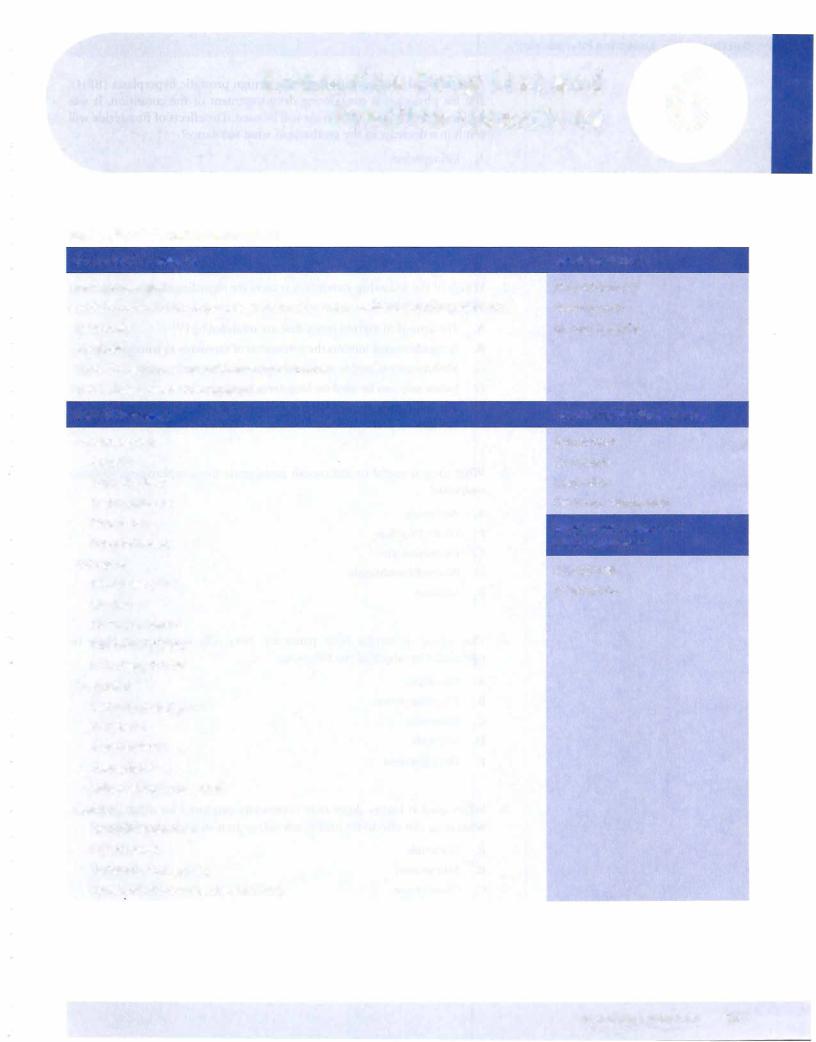
- •Contents
- •1. Pharmacokinetics
- •3. Practice Questions
- •2. Antiarrhythmic Drugs
- •3. Antihypertensive Drugs
- •3. Anticonvulsants
- •5. Opioid Analgesics
- •8. Drugs of Abuse
- •1. Antibacterial Agents
- •4. Antiprotozoal Agents
- •1. Histamine and Antihistamines
- •3. Drugs Acting on Serotonergic Systems
- •1. Drugs Used in Diabetes
- •2. Steroid Hormones
- •6. Endocrine Drug List
- •1. Anticancer Drugs
- •1. Immunopharmacology
- •1. Toxicology
- •2. Toxicology Practice Questions
- •Index

Endocrine Drug List and |
6 |
|
|
Practice Questions |
|
Table Vlll-6-1. Endocrine Drug List
Drugs Used in Diabetes
Insulins, glargine
Sulfonylureas-<:hlorpropamide, tolbutamide, cetohexamide, glipizide, glyburide Metformin
Acarbose
Thiazolidinediones-pioglitazone, rosiglitazone GLP-1 drugs-exenatide, sitagliptin
Steroid Hormones
Adrenosteroids
Cortisol
Triamcinolone
Fludrocortisone
Prednisone
Dexamethasone
Estrogens
Ethinyl estradiol
Mestranol
Diethylstilbestrol
Tamoxifen (SERM)
Raloxifene (SERM)
Progestins
Medroxyprogesterone
Norgestrel
Norethindrone
Desogestrel
Mifepristone (antagonist)
Androgens
Methyltestosterone
Oxandrolone
Flutamide (antagonist)
Finasteride (5-a-reductase inhibitor)
Antithyroid Drugs
Propylthiouracil
Methimazole
Kl and I (Lugol's)
Hypothalamic/Pituitary Drugs
Somatropin
Octreotide
Leuprolide
Oxytocin, vasopressin
Drugs Used in Bone and
Mineral Disorders
Alendronate
Teriparatide
MEDICAL 287

Section VIII • Endocrine Pharmacology
1 .
2.
3.
A 70-year-old man is diagnosed with benign prostatic hyperplasia (BPH), and his physician is considering drug treatment of the condition. It was decided that the drug finasteride willbe used. The effects offinasteride will result in a decrease in the synthesis ofwhat substance?
A.Epinephrine
B.Norepinephrine
c. Dihydrotestosterone
D.Testosterone
E.GnRH
Which ofthe following statements is accurate regarding drug management ofhyperthyroidism?
A.The actions ofthyroid peroxidase are inhibited by 1131
B.Propylthiouracil inhibits the conversion ofthyroxine to triiodothyronine
C.Methimazole is unable to cross the placental barrier
D.Iodide salts can be used for long-term management
E.The iodinationoftyrosylresiduesto form MITandDITareinhibitedbybeta blockers
What drug is useful to distinguish neurogenic from nephrogenic diabetes insipidus?
A.Amiloride
B.Demeclocycline
C.Desmopressin
D.Hydrochlorothiazide
E.Lithium
4.The release of insulin from pancreatic beta cells would most likely be stimulated by which ofthe following?
A. Clonidine
B.
c.
Norepinephrine
Diazoxide
D.Glipizide
E. Hypoglycemia
5.When used at higher doses than commonly employed for other purposes, what drug can effectively inhibit steroidogenesis in a variety oftissues?
A. Flutamide
B.Misoprostol
c. Clomiphene
D.Tamoxifen
E.Ketoconazole
288 MEDICAL

Chapter 6 • Endocrine List and Practice Questions
6.
In a patient with type 2 diabetes, which drug mimics the action of incretins to augment glucose-dependent insulin secretion?
A.Acarbose
B.Glucagon
c.Exenatide
D.Metformin
E.Rosiglitazone
7.To supplement other oral type 2 diabetes medication, a patient is prescribed a drug to inhibit the intestinal absorption of carbohydrates. What would be an appropriate drug?
A.Metformin
B.Acarbose
c.Repaglinide
D.Insulin lispro
E.Pioglitazone
8.What is the drug of choice for management of adrenal glucocorticoid induced osteoporosis?
A.Alendronate
B.Calcitonin
c.Estrogen
D.Ketoconazole
E.Vitamin D
9.Which drug has utility in inhibiting the severe secretory diarrhea of hormone-secreting tumors of the pancreas and GI tract, as well as in the treatment of acromegaly?
A.Octreotide
B.Leuprolide
c.Bromocriptine
D.Sertraline
E.Anastrazole
MEDICAL 289

Section VIII • Endocrine Pharmacology
Answers
1.Answer: C. The drug finasteride inhibits the enzyme 5-cx reductase, the enzyme that converts testosterone to dihydrotestosterone (DHT). DHT is responsible for prostate enlargement in BPH. The other commonly used drugs in BPH are alpha- 1 antagonists such as prazosin and tamsulosin.
2.Answer: B. Thioamides used at conventional doses in Graves disease are slow to act; they inhibit iodination and the coupling reactions in hormone synthesis and do not affect the release of stored thyroxine. At high doses, propylthiouracil may act more rapidly because of its inhibition of 5'-deiodinase, preventing the conversion ofT4 to T3. Thioamides are not teratogenic, and they do not decrease glandular size or vascularity; KI plus iodine (Lugol's solution) is used preopera tively to this end. Use of iodide in hyperthyroidism is only temporary because the thyroid gland "escapes" from its actions within a week or two.
3.Answer: C. Neurogenic diabetes insipidus is treated with desmopressin, a drug that is similar to vasopressin (ADH), yet is a selective activator ofV2 receptors in the kidney. Remember thatV1 receptors are present in smooth muscle, and their activation leads to vasoconstriction and bronchoconstriction. Nephrogenic diabetes insipidus (decreased response of vasopressin receptors) is treated with thiazides, except in the case of that induced by lithium, when arniloride is pre ferred (because thiazides increase blood levels of lithium). In cases where it is necessary to distinguish between neurogenic and nephrogenic, desmopressin is used. Desmopressin would alleviate the symptoms of neurogenic but have no effect in nephrogenic diabetes Insipidus.
4.Answer: D.The release ofinsulin from the pancreas is stimulated by insulinogens (glucose), sulfonylurea hypoglycemics (glipizide), activators of beta-2 adreno ceptors (e.g., albuterol), and activators ofmuscarinic receptors (e.g., pilocarpine). Activation of alpha-2 receptors inhibits insulin release (clonidine and norepin pehrine). Hypokalemia, and diazoxide, keep potassium channels on beta cells open resulting in decreased insulin release
5. Answer: E. Ketoconazole is an antifungal drug that decreases the synthesis of various steroids including cortisol and testosterone by inhibiting cyto chrome P450 enzymes. Flutamide is an androgen-receptor antagonist, and tamoxifen is a partial agonist (or mixed agonist-antagonist) at estrogen recep tors. Misoprostol is a prostanglandin analog used in NSAID-induced ulcers. Clomiphene is used to induce ovulation.
6. Answer: C. Exenatide is a glucagon-like peptide- I (GLP-1 ) analog. GLP- 1 is an incretin released from the small intestine that enhances glucose-dependent insulin secretion. Metformin is "euglycemic," lowering elevated glucose levels to the normal range, and acarbose simply prevents postprandial hyperglycemia. Glucagon causes hyperglycemia, an effect that is sometimes employed in man agement of hypoglycemia. Rosiglitazone increases the sensitivity to insulin by increasing insulin receptor numbers.
7. Answer: B. Acarbose inhibits the enzyme a-glucosidase in the brush borders of the small intestine. This decreases the formation of absorbable carboydrate and thereby decreases glucose absorption. The net effect is that glucose levels after a meal don't rise as significantly and therefore the insulin demand Is reduced.
290 MEDICAL

8.
Chapter 6 • Endocrine List and Practice Questions
Answer: A. Alendronate is currently the drug of choice to prevent osteo porosis in patients who must be maintained on steroids for their antiin flammatory and immunosuppressive effects. The drug also decreases bone resorption during menopause and is sometimes favored in patients who are at risk for neoplasias if treated with sex hormones. Care must be taken with alendronate to avoid esophageal ulceration. Estrogen hormone replacement therapy ± vitamin D also has proven valuable for slowing bone resorption in menopause, and increases in bone mass have been reported for combinations of estrogens with alendronate.
9.Answer: A. Octreotide is a somatostatin analog that is effective for carcinoid and other secretory GI tumors. It has been used to varying degrees in other forms of secretory diarrhea such as chemotherapy-induced and the diarrhea of HIV and diabetes. Octreotide has proven to be of major importance in the management of acromegaly and can significantly decrease the levels of growth hormone.
MEDICAL 291


SECTION
Anticancer Drugs

